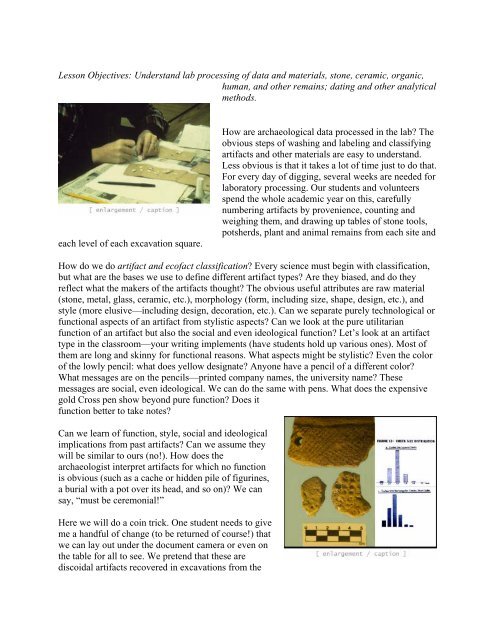INTRODUCTION TO ARCHAEOLOGY Nancy White - Touro Institute
INTRODUCTION TO ARCHAEOLOGY Nancy White - Touro Institute
INTRODUCTION TO ARCHAEOLOGY Nancy White - Touro Institute
You also want an ePaper? Increase the reach of your titles
YUMPU automatically turns print PDFs into web optimized ePapers that Google loves.
Lesson Objectives: Understand lab processing of data and materials, stone, ceramic, organic,<br />
human, and other remains; dating and other analytical<br />
methods.<br />
each level of each excavation square.<br />
How are archaeological data processed in the lab? The<br />
obvious steps of washing and labeling and classifying<br />
artifacts and other materials are easy to understand.<br />
Less obvious is that it takes a lot of time just to do that.<br />
For every day of digging, several weeks are needed for<br />
laboratory processing. Our students and volunteers<br />
spend the whole academic year on this, carefully<br />
numbering artifacts by provenience, counting and<br />
weighing them, and drawing up tables of stone tools,<br />
potsherds, plant and animal remains from each site and<br />
How do we do artifact and ecofact classification? Every science must begin with classification,<br />
but what are the bases we use to define different artifact types? Are they biased, and do they<br />
reflect what the makers of the artifacts thought? The obvious useful attributes are raw material<br />
(stone, metal, glass, ceramic, etc.), morphology (form, including size, shape, design, etc.), and<br />
style (more elusive—including design, decoration, etc.). Can we separate purely technological or<br />
functional aspects of an artifact from stylistic aspects? Can we look at the pure utilitarian<br />
function of an artifact but also the social and even ideological function? Let’s look at an artifact<br />
type in the classroom—your writing implements (have students hold up various ones). Most of<br />
them are long and skinny for functional reasons. What aspects might be stylistic? Even the color<br />
of the lowly pencil: what does yellow designate? Anyone have a pencil of a different color?<br />
What messages are on the pencils—printed company names, the university name? These<br />
messages are social, even ideological. We can do the same with pens. What does the expensive<br />
gold Cross pen show beyond pure function? Does it<br />
function better to take notes?<br />
Can we learn of function, style, social and ideological<br />
implications from past artifacts? Can we assume they<br />
will be similar to ours (no!). How does the<br />
archaeologist interpret artifacts for which no function<br />
is obvious (such as a cache or hidden pile of figurines,<br />
a burial with a pot over its head, and so on)? We can<br />
say, “must be ceremonial!”<br />
Here we will do a coin trick. One student needs to give<br />
me a handful of change (to be returned of course!) that<br />
we can lay out under the document camera or even on<br />
the table for all to see. We pretend that these are<br />
discoidal artifacts recovered in excavations from<br />
the
















